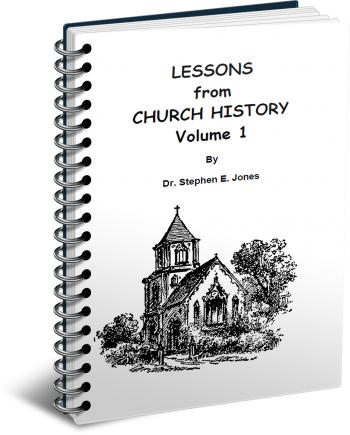Latest Posts
View the latest posts in an easy-to-read list format, with filtering options.

Volume 1. This gives a short history of the Church from the apostles to the Roman War, including Luke’s account of Paul’s journeys in the book of Acts. It includes Paul’s fourth missionary journey to Spain and Britain.
Category - History and Prophecy

We know very little about Paul's personal life. Perhaps this is because the gospels were written by men. Certainly, women would have written those personal details which we now wish we knew. Men write headlines; women write the fine print. Even so, we do know some things, and can infer some other details.
We know from Acts 22:27, 28 that Paul was born a Roman citizen, which means that his father or perhaps even his grandfather had obtained Roman citizenship for the family before Paul was even born.
We know from Acts 23:16 that Paul had a sister and a nephew living in Jerusalem, for we read of a plot to assassinate Paul for his witness in Jerusalem:
{Acts 23:16} 16 But the son of Paul's sister heard of their ambush, and he came and entered the barracks and told Paul.
Paul's sister was married, for she had a son, and they do not seem to be Christians. In fact, Paul's nephew probably heard of the plot because he was one of the trusted zealots. But they did not realize that Paul was his uncle, and upon hearing of their plot, he decided to betray their cause for the sake of family ties.
Eusebius, bishop of Caesarea in the 4th century, believed that Paul himself was married, along with other apostles. He quotes Clement, third bishop of Rome, in Eccl. Hist., III, xxx,
“Clement, whose words we have just been reading, goes on from the passage I have quoted to rebut those who deprecated marriage, by listing the apostles known to have been married men. He says, ‘Or will they condemn even the apostles? For Peter and Philip had families, and Philip gave his daughters in marriage, while Paul himself does not hesitate in one of his epistles to address his yoke-fellow, whom he did not take round with him for fear of hindering his ministry’.”
In the footnote, we read a comment: “Phil. iv. 3: though 'yoke-fellow' (syzygos) would naturally mean ‘wife,’ it could mean ‘comrade’.”
In other words, Paul's syzygos might refer to Luke as a “comrade,” but the most natural meaning of the word is WIFE. Thus, Eusebius himself takes this to mean that Paul was married. But then we read the most fascinating statement of all in Romans 16:13, where Paul writes,
{Romans 16:13} 13 Greet Rufus, a choice man in the Lord, also his mother and mine.
Most have assumed that Paul was not speaking literally here. It is inconceivable to most people that Rufus' mother could also be Paul's mother. But consider that Paul had no spiritual mother, but he certainly must have had an actual mother. Paul came to Christ by direct revelation, not through the ministry of either a man or a woman. Secondly, there is no evidence that Paul had ever been to Rome at the time he penned this letter. How could he greet Rufus' mother in such affectionate terms, if he had never met her?
There is no reason for us to doubt Paul's clear but simple statement that his own mother was also the mother of Rufus. The inference is that Paul's father had died young, and that Paul's mother had moved to Rome (as a Roman citizen) and had married Pudentinus. Still young enough to bear children, she had borne his son, Rufus, who later married Claudia.
Paul wrote his letter to the Britons in Rome about 58 A.D. If Pudens was about thirty at the time, having been married to Claudia in 53 at the age of 25, then Pudens would have been born around 28 A.D., just before Jesus began His ministry. Paul tells us that he was born in Tarsus (Acts 22:3) and that he moved to Jerusalem to study under Gamaliel—perhaps along with his sister. He was (or became) very zealous in Judaism. But meanwhile, his mother moved to Rome and married Pudentinus.
The fact that when Paul arrived in Rome, he was allowed to live under house arrest in a house, rather than remain in a prison, says something of his influence. Early Church history shows him living at the Palatium of Pudens, where their children were born and were later martyred and buried. In 1910, Edwin Wilmshurst wrote in his St. Paul and Britain,
“Cardinal Wiseman, in Fabiola, states that it was in the house of Pudens and Claudia that St. Peter lived (visited) and that the theologian, Alban Butler, calls it the most ancient church in the world. He also states that Pius I (142-157) ‘consecrated a chamber in the Bath of Novatus, as an oratory, which he made a Title (Parish), and having collated to it his brother Hermas (Pastor), it was called Titulus Pastoris. Then came to Rome the holy St. Justin, the martyr’.”
While Paul was living in Rome awaiting his first appearance before Nero, he became friends with Seneca, the Stoic Philosopher in Rome, who had been Nero's tutor. There are letters written between them, though it is not clear how authentic they are. They are published on pages 95-99 of the 1926 book, The Lost Books of the Bible. Though the title of this book is a gross exaggeration, suggesting that these ought to have been included in the Bible, the book nonetheless has value, for it brings these non-biblical books into the public arena.
Paul was acquitted by Nero in 63, and at that point Paul went first to Spain and then to Britain to preach the Word. Not only is this trip referenced in ancient sources, but the account itself is found in the 29th chapter of Acts, the so-called “Sonnini Manuscript.” (See Appendix 1.)
A 29th chapter of Acts appears at the end of the Book of Acts in the Sonnini Mansucript, which Sultan Abdoul Achmet gave to the French Ambassador Sonnini in his travels through the Ottoman Empire (modern Turkey) during the late 1700’s. This final chapter records Paul's visit to Spain and to Britain, where he was treated well by the Druids, who told him of their descent from Israel. Paul preached upon Mount Lud (now Ludgate Hill and Broadway, where St. Paul's Cathedral now stands in London).
Major Samuels, in his book, Far Hence Unto the Gentiles, writes about the authenticity of this manuscript:
“Louis XVI reigned from A.D. 1774 to 1793, when the French Revolution began, so that M. Sonnini must have published his Book of Travel in Turkey and Greece sometime between those two dates. . . It is absurd to suggest that he deliberately invented this manuscript. What possible reason could he have for so doing? What did people know or care about the Druids or St. Paul in his day? Moreover, if he had possessed the necessary knowledge to perpetrate a literary forgery of this description, would he have resisted the temptation to glorify his own country in preference to that of England, France's bitterest enemy, at that time? . . . Its preservation was no doubt due to the fact that it fell into, and remained in, the custody of the Turks at Constantinople instead of falling into the hands of the Western Christian Church at Rome.”
The Roman Church probably would have destroyed it or hidden it in its own archives in order to preserve its own prestige as the supposed Mother Church.
Upon Paul's return, he was arrested again and martyred in 65-66 A.D. along with Peter. Seneca had meanwhile fallen out of favor with Nero, who had ordered him to commit suicide in 65. So he was unable to assist Paul in any meaningful way.
In later years, Linus was martyred in 90 A.D. His brother-in-law, Pudens, was martyred in 96 A.D., about the time that John was exiled to Patmos and began writing the Book of Revelation. Claudia died a natural death a year later before any of her children suffered martyrdom.
Claudia's daughter, Pudentiana, is said to have suffered martyrdom in 107 A.D., on the anniversary of her father's death. Claudia's son, Novatus, was martyred in the fifth persecution in A.D. 139, while his brother Timothy was in Britain baptizing his uncle’s grandson, King Lucius. Timothy later returned and, at the age of 90, suffered martyrdom in Rome.